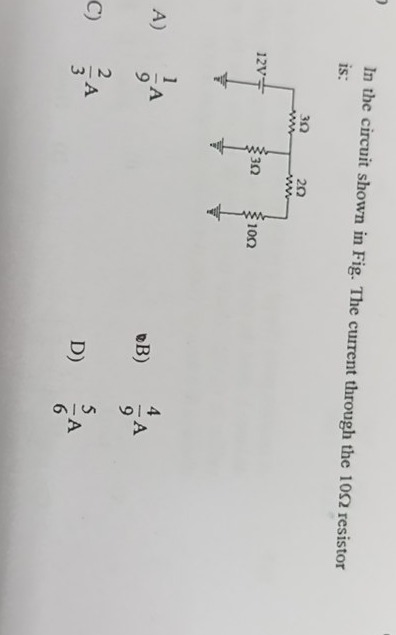Question
Question: In the circuit shown in Fig. The current through the 10$\Omega$ resistor is:...
In the circuit shown in Fig. The current through the 10Ω resistor is:

91A
94A
32A
65A
94A
Solution
The circuit can be analyzed using nodal analysis. Let the potential at the top node connected to the positive terminal of the 12V source be VA=12V. The ground potential is 0V. Let VB be the potential at the junction between the two 3Ω resistors and the 2Ω resistor. Let VC be the potential at the junction between the 2Ω resistor and the 10Ω resistor.
Applying Kirchhoff's Current Law (KCL) at node B:
The current from node A to node B through the 3Ω resistor is IAB=3VA−VB=312−VB.
The current from node B to ground through the 3Ω resistor is IB−ground=3VB−0=3VB.
The current from node B to node C through the 2Ω resistor is IBC=2VB−VC.
According to KCL at node B, the sum of currents entering the node equals the sum of currents leaving the node:
IAB=IB−ground+IBC
312−VB=3VB+2VB−VC
Multiplying by 6 to clear the denominators:
2(12−VB)=2VB+3(VB−VC)
24−2VB=2VB+3VB−3VC
24=7VB−3VC (Equation 1)
Applying KCL at node C:
The current from node B to node C through the 2Ω resistor is IBC=2VB−VC.
The current from node C to ground through the 10Ω resistor is IC−ground=10VC−0=10VC.
According to KCL at node C:
IBC=IC−ground
2VB−VC=10VC
Multiplying by 10 to clear the denominators:
5(VB−VC)=VC
5VB−5VC=VC
5VB=6VC (Equation 2)
Now we have a system of two linear equations with two variables VB and VC:
- 7VB−3VC=24
- 5VB=6VC
From Equation 2, we can express VB in terms of VC:
VB=56VC
Substitute this expression for VB into Equation 1:
7(56VC)−3VC=24
542VC−3VC=24
To combine the terms with VC, find a common denominator:
542VC−515VC=24
542−15VC=24
527VC=24
VC=2724×5=9×38×3×5=940V
The current through the 10Ω resistor is the current from node C to ground, which is given by Ohm's Law:
I10Ω=10VC−0=10VC
I10Ω=1040/9=9×1040=9040=94A
